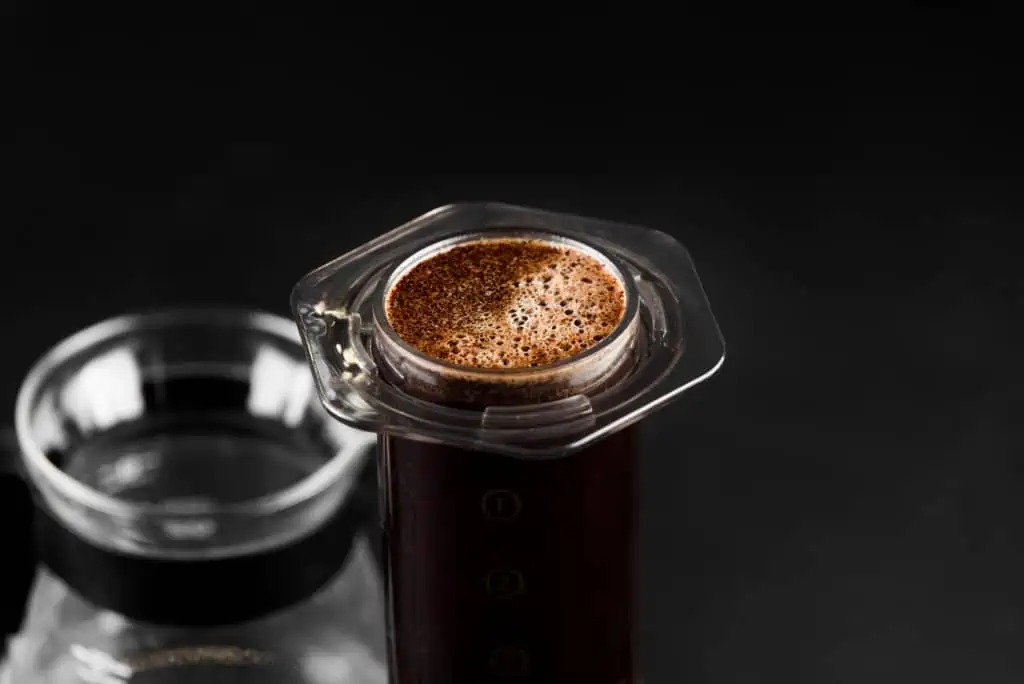
About five years ago or so Alan Adler, the inventor of the Aerobie Flying Disk, created the Aeropress because he wanted a cup of coffee was full and rich, similar to the results from a French press but with cleaner, less acidy attributes. After some experiments and prototyping, Alder solicited feedback about his creation from well-known coffee professionals before releasing it to the market. The critics loved it and the popularity of this device and new ways to use it continue to grow.
I will totally admit that it took me a long time to get on the Aeropress band wagon. When I first saw the device a few years back I even outright dismissed it. There was no way I was going to brew a cup of coffee for myself in something entirely made from plastic. This really had nothing to do with any BPA poisoning fear, but far more to do with my numerous experiences with cheap drugstore coffee makers and plastic lined travel mugs that destroyed coffee by giving the brew a clear and distinct plastic flavor taint. In fact it was not until 2008, and the first Aeropress World Championship that I started to think that maybe there was something to this gizmo. This, plus my growing love affair with single cup, manual brewing methods and devices that made me want to test winning brewing methods with the Aeropress as well as create my own special technique.
Brewing Technique
With so many baristas and home coffee geeks fooling around out there there are plenty of Aeropress brewing techniques available for viewing on the Internet, and The World Aeropress Championship web site displays the winning brew recipes from past competitions. There are also instructions that come with the brewer, though I did not like the results that I got from them. I must say that the method I developed is inspired from many that are on the net and has been altered to satisfy my taste. I would encourage experimentation to achieve a brew that suits you, and is easy for you to replicate.
To start, you will need:
- Fresh roasted coffee, preferably from a local roaster. I have used pre-ground, grocery store coffee in the Aeropress while staying with relatives with some pretty amazing results in comparison to the traditional drip brewer. The best results will always be with fresh roasted coffee.
- An adjustable burr grinder.
- A digital kitchen scale to weigh out both the coffee and the water while brewing.
- An electric or stove-top kettle to heat the water.
- A thermometer to measure the temperature of the water. Proper brewing temperature is important to avoid having off flavors in you cup. 200-203 degrees Fahrenheit is optimal.
- The Able Disk. This is a re-usable metal filter made by the same company that created the Coava Kone. The Aeropress comes with paper filters and they work very well, however I prefer the small amount of fine coffee particles that the disk allow to pass through. It creates a silkier mouthfeel that I find particularly appealing. Paper filters filter out the sediment, so if you prefer a cleaner cup of coffee with more acidity then you’ll want to use them instead of the disk.
- A timer that reads minutes and seconds. Timing is a critical part of this brewing method and can make a huge difference in the final cup quality.
- A standard size coffee mug.
The Aeropress is a three piece device that closely resembles a syringe. There are two cylinders, one of which fits snugly into the other. Both are flanged at one end. The smaller of the two is the plunger and has a rubber piece at the non-flanged end that creates a water tight seal when inserted into the brewing chamber (the larger of the two cylinders). The third piece is a black perforated filter holder that is about one half inch deep. A filter is placed inside and secured to the brewing chamber with a quick twist.
My technique, and those that are similar, are collectively called the upside down brew method. To start out you’ll need to disassemble the Aeropress by removing the black filter cap as well as the plunger. Set the black filter holder so that you can place the Able Disk into it with the words facing up. Next you’ll want to wet the black rubber on the plunger in order to create some lubrication when you press out your final brew. The Aeropress had graduation markings from one to four and you’ll want to push the plunger to just above the four mark so that you’ll be able to get the right amount of water into the chamber. After this is done place the Aeropress on a flat surface plunger side down.
By now you should have started a kettle of fresh cool water to boil. Keep in mind that you’ll want to let the water cool from boiling to between 200 and 203 degrees Fahrenheit for optimum flavor extraction.
Weigh out 16.5 grams of coffee and grind slightly just finer than you would for an automatic brewer and pour it into the Aeropress using the funnel that is included. It’s important to level out the grounds in the chamber so that when you pour your water you’ll be able to evenly saturate the coffee. This can be done by simply shaking the entire brewer gently from side to side or lightly tapping it with your hand.
Next, place the brewer on your digital scale and hit the tare/zero button so that the display reads zero, start your timer counting up and start pouring in your hot water. I have found that to properly saturate all the ground coffee that I need to employ a bit of technique when I pour. Start the pour slowly and aim a thin stream of water straight down the side of the brew chamber and slowly twist the entire brewer 360 degrees. When the water level is just about between the two and three marks remove your hand so that you will get an accurate weight reading on the scale and pour directly in the middle of the brew chamber. The total amount of water that you pour should be 235 grams and the pour itself should take approximately 15 to 25 seconds.
If you have very fresh coffee, one to ten days off roast, you will notice foam develop while you are pouring. This is the coffee releasing gases that are still trapped within the grounds; this foam will mostly dissipate in about 20 seconds. Once it has, secure the filter holder with the Able Disk inside onto the brewer and at one minute twenty five seconds carefully flip the brewer onto the top of you mug. Wait about five seconds for the brewing coffee grounds inside to rise to the top and begin to press the plunger down. Your total press time should be between thirty and forty five seconds making the total brew time right about two minutes. Now all you have to do is sit back and enjoy the coffee.
Clean up of the Aeropress and the disk is simple and takes only seconds. You just remove the cap and the disk and push out the spent grounds by pressing the plunger all the way in, then rinse off the disk. I like to hold the disk up to a light source after rinsing to make sure that there are no grounds stuck in it. If there are, you can use a tooth brush or some other soft bristled scrubber to remove them. The brewing chamber has already been cleaned by the plunger so you just need to rinse the coffee off the end, wipe it with a clean dry towel and you’re finished.
The Aeropress can be found in use and for sale at many quality coffee shops for around US$30.00 and the Able Disk for around US$15.00 so the investment is miniscule when you compare it to the quality of coffee that you are able to achieve.











